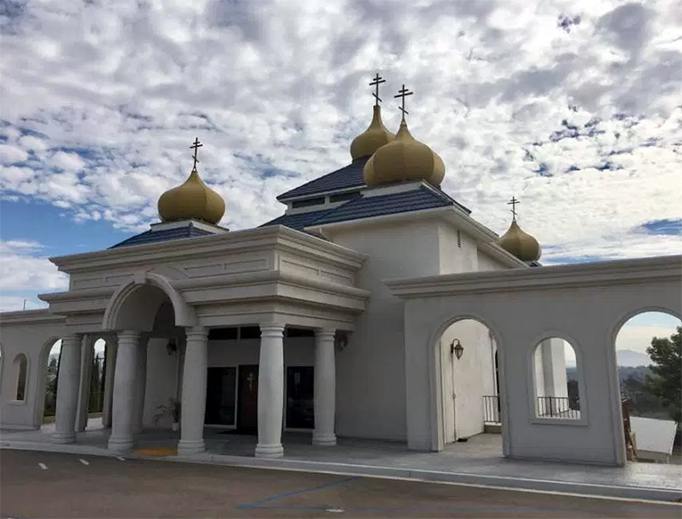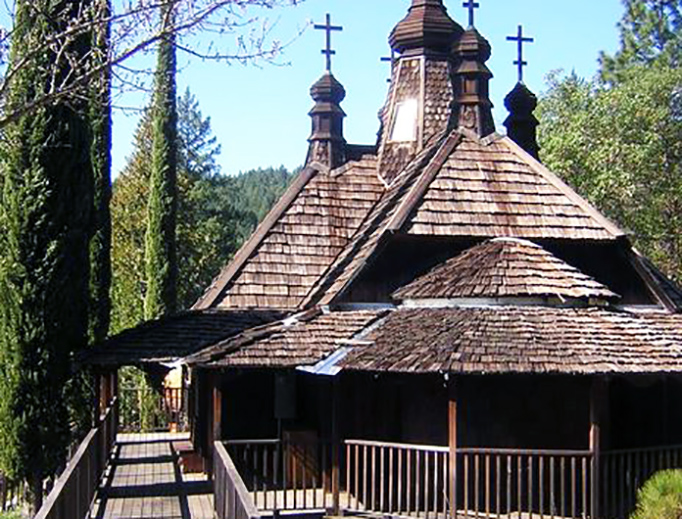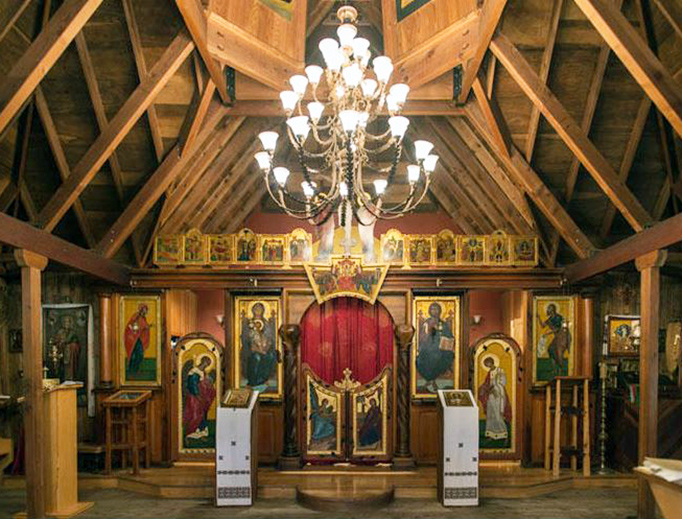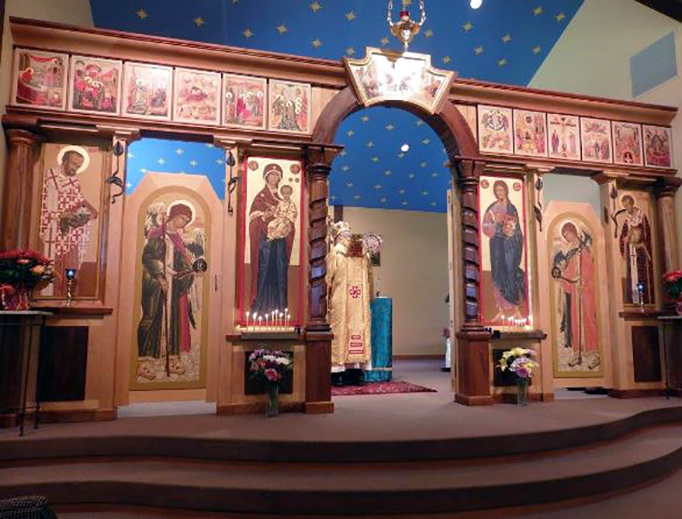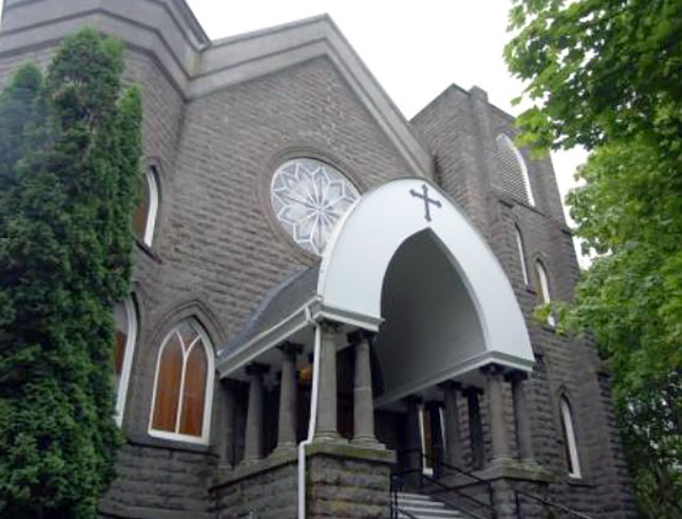5 Eastern Catholic Churches to Visit on the West Coast
Each of these churches is special in its own way and visitors are always welcome.

The Catholic Church in the United States is dominated by Latin Rite parishes, but Eastern Rite parishes in union with Rome might be a welcome alternative to some Catholics. Here are four Eastern rite parishes and one monastery in union with the Holy Father on the West Coast of the United States. Each is special in its own way and welcome visitors, so drop in when you’re in the area.
Holy Transfiguration Monastery, 17001 Tomki Road, Redwood Valley, California (www.monksofmttabor.com) – Holy Transfiguration Monastery is a contemplative, Eastern Catholic monastery, part of the Ukrainian Greek Catholic Church under the leadership of Sviatoslav Shevchuk, patriarch of the Ukrainian Greek Catholic Church. Although the church serves people of Ukrainian ancestry, all are welcome to attend.
The monks arrived in California in 1974, led by a Belgium-native, Fr. Boniface Luykx. The local bishop gave permission for them to begin their monastery. The monks spend several hours daily in the church in prayer, and engage in monastic ascetic practices such as fasting and vigils.
Today, Holy Transfiguration is home to a small community of monks. Guests are welcome to participate in their prayer life. Buildings include a chapel, outdoor chapel, retreat house, dining room, bookstore and residence for the monks (with private cells). There is also an outdoor hiking trail. Buildings have the classic, onion-shaped domes and crosses, and are made of bare wood common to the region.
Fr. Damian Higgins serves as abbot. He came to the community in 1988, and has since become a talented iconographer. View and purchase his icons (and other items) at http://www.catholictothemax.com/brands/Icons.html. Proceeds support the monastery. Fr. Damien also offers classes in painting icons.
The monks celebrate the Byzantine liturgy. Monday-Friday, Matins begins at 5:30 a.m., followed by Divine Liturgy; Saturday, Matins and Divine Liturgy at 6 a.m.; Sunday, 10 a.m. Divine Liturgy. There are many icons, which are considered windows to heaven, throughout the church. Ask one of the priests if you wish to go to confession. Guests are welcome for retreats.
The monastery is located in the Diocese of Santa Rosa, 5 miles north of the town of Redwood Valley. The monastery overlooks the valley. The area is lush with many trees, as well as vineyards and wineries. Please remember to wear appropriate attire (e.g., no shorts or short dresses allowed).
An interesting historic note: Redwood Valley was once the home of the Jim Jones People’s Temple (1965-74). They relocated to South America and engaged in mass suicide.
St. Sharbel Maronite Catholic Church, 1804 SE 16th, Portland, Oregon (www.stsharbel.org) – St. Sharbel is the only Maronite parish in the Pacific Northwest. It was founded in 1970.
The Maronite Church is an Eastern Catholic Church with a patriarch and over 40 bishops who shepherd eparchies (dioceses) throughout the world, including two in the United States. St. Sharbel is part of the Eparchy of Our Lady of Lebanon of Los Angeles led by Bishop Abdallah Zaidan.
The Maronites profess the same faith and moral beliefs as Latin-rite Catholics and share the same seven sacraments. However, Maronites have a unique liturgy, theology, spirituality and discipline. Attend Sunday liturgy at St. Sharbel, for example, you’ll see Eastern vestments and a small hand cross that the priest uses to bless the congregation. He is assisted by altar servers of varying ranks (e.g., deacon, subdeacon). Congregations rarely kneel but stand, the faithful bow to the tabernacle rather than genuflect, incense is frequently used and for Holy Communion, the Host is dipped into the chalice and given to the communicant on the tongue, not the hand. The consecration is done in Aramaic, the language of Christ.
The Maronite Church dates back to the early Christians of Antioch where “they were called Christians for the first time.” (Acts 11:26). The church still uses Syriac as her liturgical language; Syriac is a dialect of the Aramaic that Jesus himself spoke. She takes her name from the hermit-priest, St. Maron, who died in AD 410. After St. Maron’s death, 800 monks adopted his way of life and became known as the Maronites. Muslim invasions and conflicts from within the Byzantine Empire caused the Maronites to flee the plains of Syria to the protection of the mountains of Lebanon. By 687, the Maronites elected a patriarch of the vacant See of Antioch and developed as a distinct church within the Catholic Church.
The Maronites began immigrating to the United States in the 19th century. In addition to priests, the Maronites also have communities of religious men and women. There are nearly 90 Maronite parishes and missions across the United States.
St. Sharbel’s is an attractive stone church—once used by Protestants—in the unique, beautiful and historic Ladd’s Addition neighborhood in Southeast Portland (not far from the well-known Oregon Museum of Science & Industry). Streets are lined by beautiful elm trees, with rose gardens and diagonal, zigzagging streets (might be confusing for a first-time visitor to navigate). The St. Sharbel altar is actually in a corner area of the church, rather than along a flat wall as in the typical church, and the altar rail is curved in a semi-circle shape. There are many traditional statues and paintings near the altar.
Holy Mysteries (the liturgy) are held Sundays, 10:30 a.m. (in English, Arabic and Aramaic). Be prepared for a liturgy that runs a few hours. Go to confession beforehand, on Sundays between 9:15 and 10:15 a.m.
St. Sharbel’s former pastor for 26 years, Abouna Jonathan Decker, left the parish to establish the Maronite Monks of Jesus, Mary and Joseph, a new monastic order in Castle Rock, Washington. They, too, are worth a visit (http://www.maronitemonastery.com/).
Our Lady of Fatima Byzantine Catholic Church, 5920 Geary Blvd., San Francisco 94121 (www.byzantinecatholic.org, in the Richmond district, four blocks north of the Golden Gate Park).
The Our Lady of Fatima community of San Francisco was established in 1950. Its purpose was to serve Russian Byzantine Catholics fleeing communism in the Soviet Union. Their first center, an old mansion on 20th and Lake Street, was purchased in 1955. The center was named for Our Lady of Fatima because of the Blessed Mother’s promise to the three children of Fatima that one day Russia would be converted. Our Lady of Fatima recently relocated to a former convent of St. Monica’s Roman Catholic Church.
The church is in union with Rome, and is a parish of the Archdiocese of San Francisco. While primarily established to serve Russian expatriates, the center also serves a secondary purpose of introducing Latin-rite Catholics to the Byzantine rite and Russian spiritual heritage.
Byzantine worship follows its own liturgical calendar, has its own ritual and even uses leavened bread. Prayers are lengthy; when mentioning God’s name, for example, you’ll find it accompanied with multiple adjectives about His goodness, mercy, power and providence. The interior of the church, with its many icons, including an icon screen, stresses that worshippers are in God’s presence and the company of saints. Lots of incense is used; processions are part of the services. The faithful stand for most of the liturgy (but sit at the homily). Reception of the “precious gifts” is on a spoon. The Byzantine liturgy is sung without musical accompaniment.
Divine Liturgy is held Sundays, 10 a.m., with a fellowship meal following. Visitors are most welcome.
Nativity of the Mother of God Ukrainian Catholic Church, 704 Aspen Street, Springfield, Oregon (www.nativityukr.org) – Nativity is a small but vibrant parish in Western Oregon. It was established in 1979. It is under the authority of the Ukrainian Catholic Bishop of Chicago, who is under the authority of the Bishop of Rome. The current church building was completed in 1990.
Nativity celebrates the Byzantine liturgy of St. John Chrysostom. While it is essentially the same Eucharistic celebration with which Latin Rite Catholics are familiar, its outward expression differs. The liturgy is sung; most prayers are in English but some are in Slavonic and Ukrainian. There is a significant use of icons and gestures and a different emphasis on the practice of spirituality. See the website for a more information.
Divine Liturgy is held Sundays at 10 a.m. Confessions are held before and after the liturgy. Fr. Richard Janowicz has served as pastor since 1981.
Holy Angels Byzantine Catholic Church, 2235 Galahad Road, San Diego, California (www.holyangelssandiego.com) -- Holy Angels Byzantine, too, has different customs and ways of celebrating liturgy. It traces its roots back to Constantinople (once called Byzantium). Two Greek missionaries, Cyril and Methodius, brought the Byzantine way of worship to Central and Eastern Europe. Some of these Catholics emigrated to the United States, and brought with them the Byzantine rite and traditions. Holy Angels is part of the Holy Protection Eparchy (diocese) of Phoenix (www.eparchyofphoenix.org). Liturgy was first celebrated for the mission community in 1958. Holy Angels became a parish in 1960; it moved to its current location in 1973, with the current church having been built in 1978, followed by renovations beginning in 2005. One of the church’s most prominent features is its icons, or “windows into heaven,” which are all over the church, and an icon screen in the front of the church. The screen has “holy doors” in the middle, which represent the gates to heaven.
Sunday Divine Liturgy is held at 9 a.m. It is mostly in English and entirely sung. There is no kneeling, parishioners usually stand or sit. All ages receive Holy Communion; the host is dipped into the chalice with a spoon and administered to the faithful. (If your small children are in attendance, they must first join the parish—and the Byzantine rite—before going to Communion.) Other features of the liturgy you’ll notice include bowing, incense and continuous singing/chanting.
